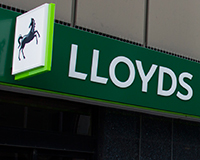 More than 600 high street bank branches have closed over the past year as the rise of online banking prompts portfolio restructuring in the sector.
More than 600 high street bank branches have closed over the past year as the rise of online banking prompts portfolio restructuring in the sector.
Last week Lloyds added some 400 shops to that total despite posting healthy pretax profits of £2.5bn for the six months ended 30 June. Unlike fashion retail closures, these closures are driven not by falling sales but by a change in consumer behaviour.
Presenting Lloyds’ 2016 half-year results, group chief executive António Horta-Osório said: “We said previously that we would complete our existing branch closure and role reduction plans ahead of schedule.
“As a result of this progress and evolving customer behaviour, we are announcing additional initiatives, including further branch closures and role reductions, to be completed by the end of 2017.”
At Royal Bank of Scotland, in-branch transactions have fallen by 43% since 2010, while its daily online banking log-ins have averaged 9.6m so far this year.
Lloyds, RBS, HSBC, Santander, Barclays and the Co-operative have all closed branches, with some 3,000 high street branches shut over the past decade, according to the Campaign for Community Banking Services. Around 8,000 high street bank branches remain open.
Although the banks’ decision to rationalise their estates is not distress-driven, it will still mean more empty space on the high street. For developers and investors, these closures could present opportunities.
Banks held on long leases are typically seen as secure investments. Those nearing the end of their terms offer good development opportunities.
Banks are also traditionally well maintained, and often in listed buildings.
Given that the majority of the planned branch closures will involve the least valuable assets, the banks left on the high street will be the top properties in the portfolios, and should attract investors, said agents.
Banks are keen on sale and leasebacks, which demonstrate their commitment to the property, and often turn to the auction room to realise these deals. Charlie Powter, an auctioneer at Acuitus, said: “Investors are clever in the way they look at properties. They will want to buy the best sites and will be willing to pay keener yields for them.”
In prime areas, the surplus space will be easily relettable. Lloyds branches range in size between 6,000 and 8,000 sq ft and often carry an A2 use class. This class is easy to change to leisure use, which is becoming a popular way to rejuvenate high streets.
The former branches are expected to attract attention from restaurant chains, many of which are targeting regional towns.
Metro Bank, the only high street bank still expanding, is also a potential new tenant. It has opened 41 banks over the past six years, with a further 59 expected to open by 2020.
So, while the demise of BHS and Austin Reed may have left some landlords out of pocket, bank closures may portend profitable opportunities.
| NUMBER OF BANKS CLOSED, APRIL 2015-APRIL 2016 | |
|---|---|
| RBS | 166 |
| HSBC | 146 |
| Barclays | 110 |
| Santander | 60 |
| Lloyds Group | 60 |
| Co-operative Bank | 55 |
• To send feedback, e-mail amber.rolt@estatesgazette.com or tweet @amberrolt or @estatesgazette










